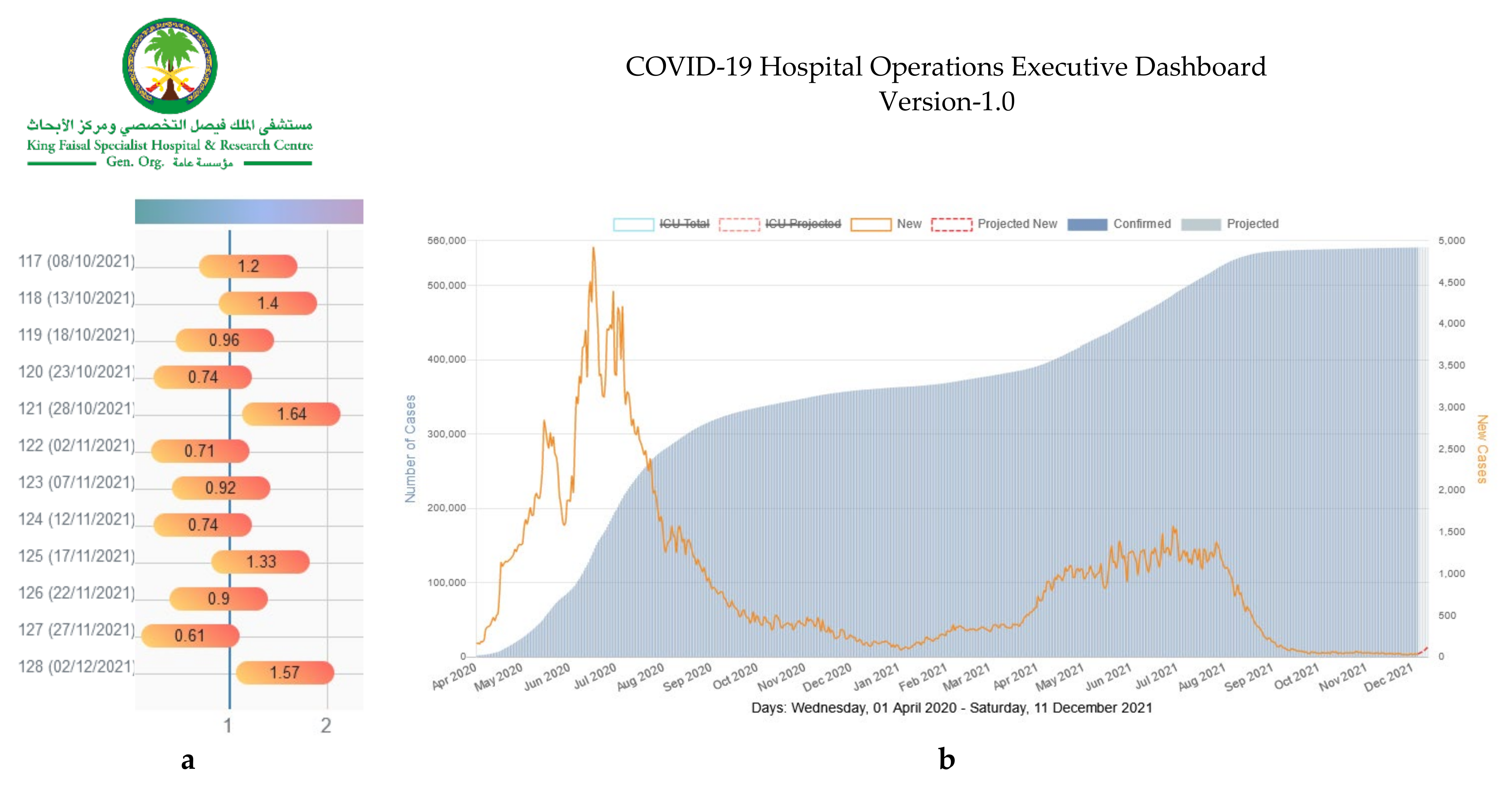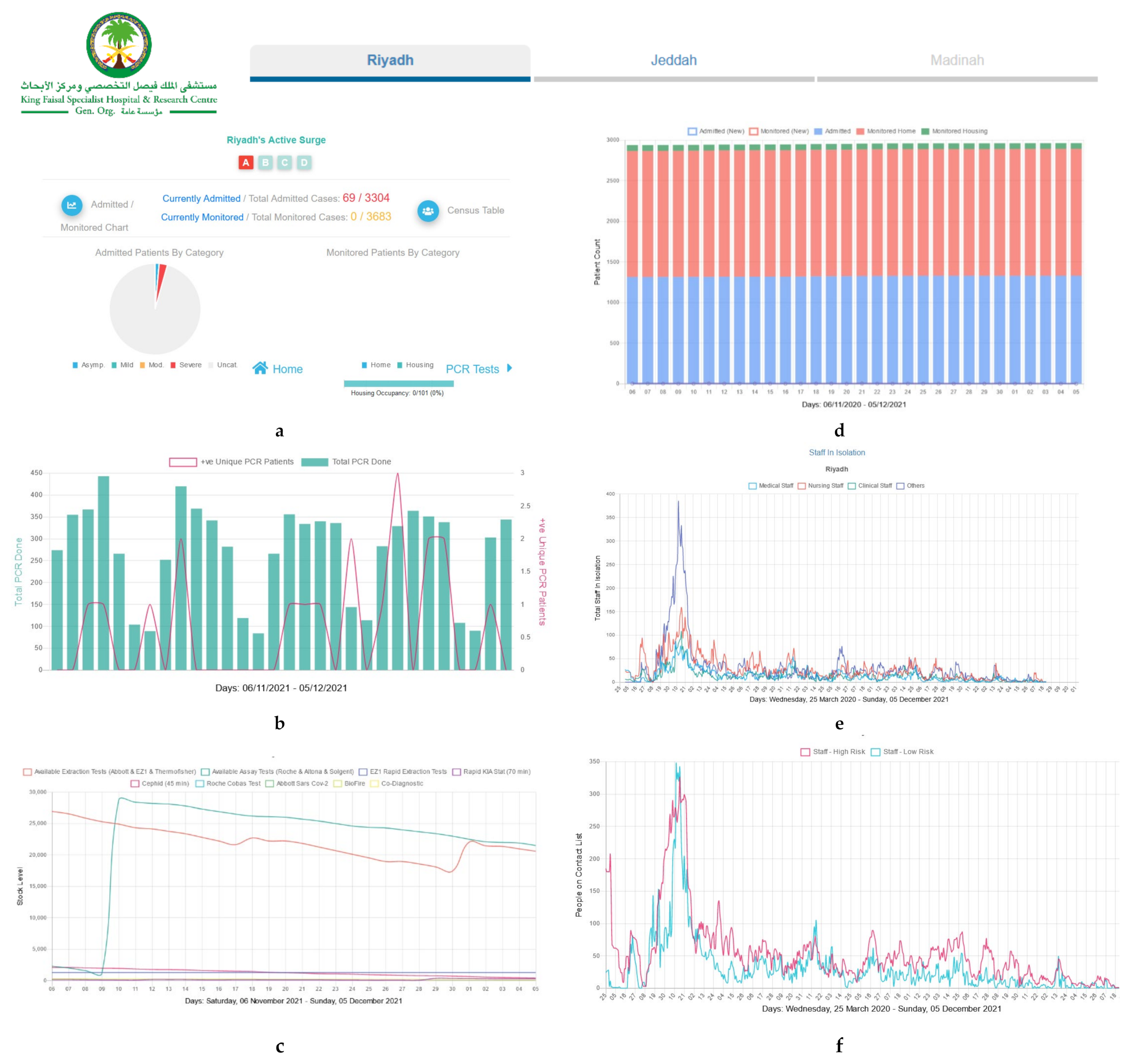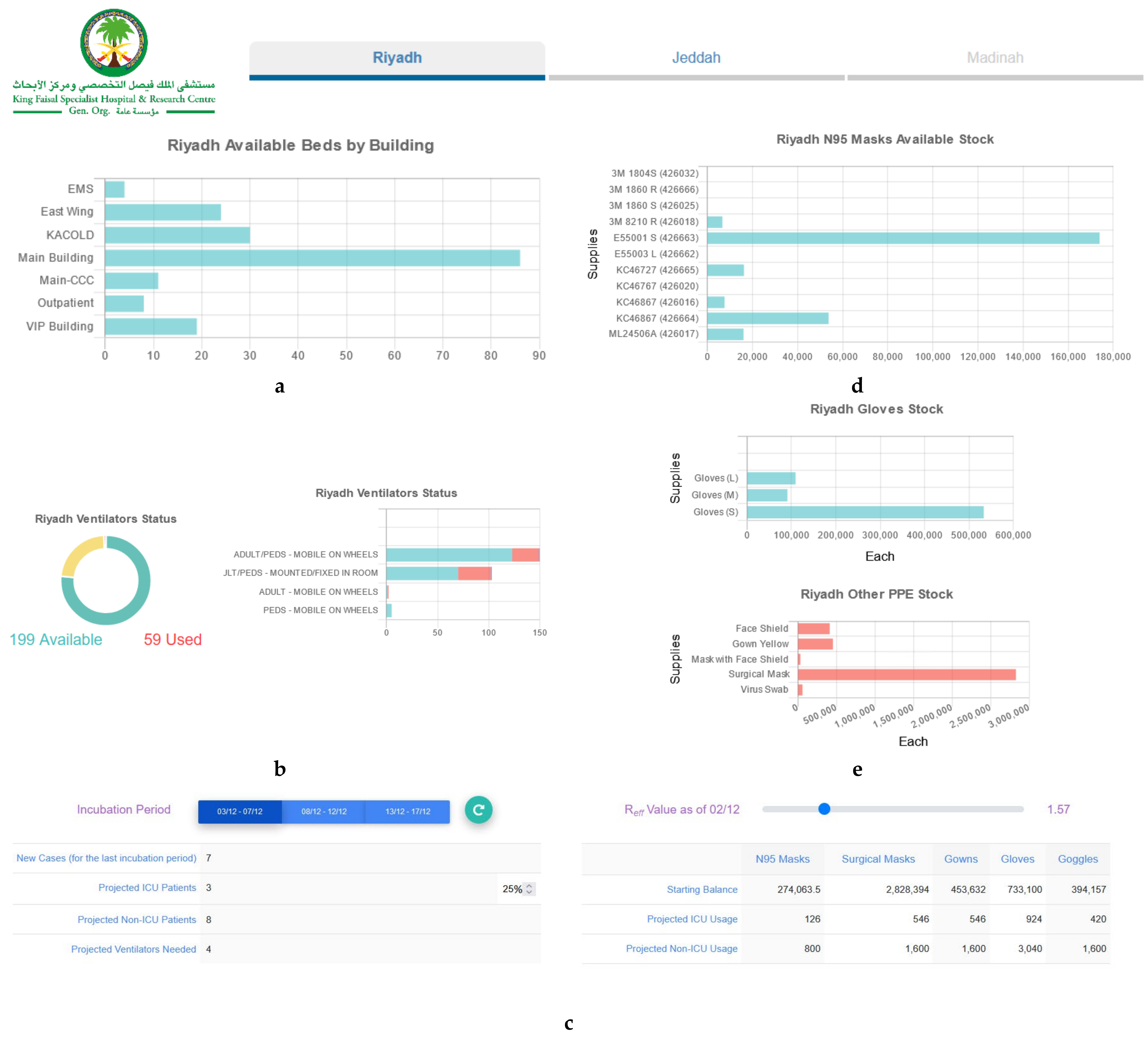COVID-19 Intelligence-Driven Operational Response Platform: Experience of a Large Tertiary Multihospital System in the Middle East
Abstract
:1. Introduction
2. Materials and Methods
2.1. Stakeholders & Need Analysis
2.2. Development Methodology
2.3. Multi-Dimensional Data Sources
3. Results
4. Discussion
- Leverage existing and available digital and analytics infrastructure capabilities of your organization to the full extent possible. This shall streamline the development process, enhance the user experience, and ensure smooth integration with various systems. At the beginning of the outbreak, there was a clear lack of readily available, accurate and easy to integrate off-the-shelf solutions. Various commercial solutions have become available over time, but the continuous need for customization and business updates are required and come at a steep unmanageable cost as the world’s knowledge and management of COVID-19 evolves.
- Build standardized data feeds and pipelines that leverage code sets standards for conditions, lab tests, and other data sources. This is critical for system scalability, component reusability, and uniform data integration. This facilitates the rapid implementation of continuously changing stakeholders’ needs. It is also required for enabling effective data liquidity, which was a key design principal given the need for data to flow across various entities in the healthcare system.
- The initial project stakeholders’ group shall include influential organization leaders with high interest in building operational intelligence platforms for the support of data-driven decision-making process. This group can quickly identify business priorities, top concerns, implementation timelines, other needed stakeholders, and scope of work. This will empower the implementation team to be fully aligned with actual organization needs. It also allows stakeholders to quickly illustrate the value and impact of the new system.
- RAD methodology can speed up the delivery process of software development. A very strong collaboration between stakeholders and developers is required to ensure successful implementation of this methodology. The rapid prototyping and speedy end-user feedback were critical factors for enhancing productivity and illustrating system value at a shorter time period.
- Building near real-time data feeds is better than real-time. While speed is important in operational intelligence, it is still acceptable to refresh your visualization every few minutes in lieu of seconds. This will reduce the load on your IT infrastructure and allows end users to comprehend the visualized data before being updated. For example, near real-time data showed good-enough insights for analyzing supplies consumption and staff availability.
- Regularly maintain the system by dropping unneeded features, adding new data elements, and building nicer visualizations. This is critical as COVID-19 may have unpredictable future waves. Utilization of various systems features can be used as a key driver for future system enhancement.
5. Conclusions
Author Contributions
Funding
Institutional Review Board Statement
Informed Consent Statement
Data Availability Statement
Conflicts of Interest
References
- Thomas, T.; Laher, A.E.; Mahomed, A.; Stacey, S.; Motara, F.; Mer, M. Challenges around COVID-19 at a tertiary-level healthcare facility in South Africa and strategies implemented for improvement. SAMJ 2020, 110, 964–967. [Google Scholar] [CrossRef] [PubMed]
- Legido-Quigley, H.; Asgari, N.; Teo, Y.Y.; Leung, G.M.; Oshitani, H.; Fukuda, K.; Cook, A.R.; Hsu, L.Y.; Shibuya, K.; Heymann, D. Are high-performing health systems resilient against the COVID-19 epidemic? Lancet 2020, 395, 848–850. [Google Scholar] [CrossRef] [Green Version]
- Peiffer-Smadja, N.; Lucet, J.C.; Bendjelloul, G.; Bouadma, L.; Gerard, S.; Choquet, C.; Jacques, S.; Khalil, A.; Maisani, P.; Casalino, E. Challenges and issues about organizing a hospital to respond to the COVID-19 outbreak: Experience from a French reference center. Clin. Microbiol. Infect. 2020, 26, 669–672. [Google Scholar] [CrossRef] [PubMed]
- Dixit, R.A.; Hurst, S.; Adams, K.T.; Boxley, C.; Lysen-Hendershot, K.; Bennett, S.S.; Booker, E.; Ratwani, R.M. Rapid development of visualization dashboards to enhance situation awareness of COVID-19 telehealth initiatives at a multihospital healthcare system. J. Am. Med. Inf. Assoc. 2020, 27, 1456–1461. [Google Scholar] [CrossRef] [PubMed]
- Grange, E.S.; Neil, E.J.; Stoffel, M.; Singh, A.P.; Tseng, E.; Resco-Summers, K.; Fellner, B.J.; Lynch, J.B.; Mathias, P.C.; Mauritz-Miller, K. Responding to COVID-19: The UW Medicine Information Technology Services Experience. Appl. Clin. Inform. 2020, 11, 265–275. [Google Scholar] [CrossRef] [PubMed] [Green Version]
- Hollander, J.E.; Brendan, G.C. Virtually perfect? Telemedicine for COVID-19. N. Engl. J. Med. 2020, 382, 1679–1681. [Google Scholar] [CrossRef] [PubMed]
- Iezzi, R.; Valente, I.; Cina, A.; Posa, A.; Contegiacomo, A.; Alexandre, A.; D’Argento, F.; Lozupone, E.; Barone, M.; Giubbolini, F.; et al. Longitudinal study of interventional radiology activity in a large metropolitan Italian tertiary care hospital: How the COVID-19 pandemic emergency has changed our activity. Eur. Radiol. 2020, 30, 6940–6949. [Google Scholar] [CrossRef] [PubMed]
- Papi, C.; Spagni, G.; Alexandre, A.; Calabresi, P.; Della Marca, G.; Broccolini, A. Unprotected stroke management in an undiagnosed case of Severe Acute Respiratory Syndrome Coronavirus 2 infection. J. Stroke Cerebrovasc. Dis. 2020, 29, 104981. [Google Scholar] [CrossRef] [PubMed]
- Wong, J.; Goh, Q.Y.; Tan, Z.; Lie, S.A.; Tay, Y.C.; Ng, S.Y.; Soh, C.R. Preparing for a COVID-19 pandemic: A review of operating room outbreak response measures in a large tertiary hospital in Singapore. Can. J. Anesth./J. Can. D’anesthésie 2020, 67, 732–745. [Google Scholar] [CrossRef] [PubMed] [Green Version]
- King Faisal Specialist Hospital and Research Centre Family Medicine Clinic Jeddah Achieves HIMSS Analytics O-Emram Stage 7 Award. Available online: https://www.himssanalytics.org/asia-pacific/king-faisal-stage-7 (accessed on 1 April 2021).
- King Faisal Specialist Hospital and Research Centre Is First Organization Outside North America to Reach HIMSS Analytics AMAM Stage 6 Award. Available online: https://www.himssanalytics.org/middle-east/king-faisal-specialist-hospital-research-centre-first-organization-outside-north-america (accessed on 1 April 2021).
- King Faisal Specialist Hospital and Research Center Embraces Digital Healthcare Transformation. Available online: https://www.himss.org/news/king-faisal-specialist-hospital-research-center-embraces-digital-healthcare-transformation (accessed on 1 April 2021).
- TransformativeMed and King Faisal Specialist Hospital and Research Centre Form Multilayer Partnership to Accelerate Specialty Workflows Kingdom-Wide. Available online: https://chimecentral.org/transformativemed-and-king-faisal-specialist-hospital-and-research-centre-form-multilayer-partnership-to-accelerate-specialty-workflows-kingdom-wide/ (accessed on 1 April 2021).
- Saudi Arabia Reports First Coronavirus Case, A Saudi National Coming from Iran. Available online: https://english.alarabiya.net/News/gulf/2020/03/02/Saudi-Arabia-reports-first-coronavirus-case-state-media (accessed on 1 March 2021).
- Saudi Arabian Dashboard for the Spread of COVID-19. Available online: https://covid19.moh.gov.sa/ (accessed on 1 March 2021).
- Assiri, A.; McGeer, A.; Perl, T.M.; Price, C.S.; Al Rabeeah, A.A.; Cummings, D.A.; Alabdullatif, Z.N.; Assad, M.; Almulhim, A.; Makhdoom, H. Hospital outbreak of Middle East respiratory syndrome coronavirus. N. Engl. J. Med. 2013, 369, 407–416. [Google Scholar] [CrossRef] [PubMed]
- Assiri, A.; Al-Tawfiq, J.A.; Al-Rabeeah, A.A.; Al-Rabiah, F.A.; Al-Hajjar, S.; Al-Barrak, A.; Flemban, H.; Al-Nassir, W.N.; Balkhy, H.H.; Al-Hakeem, R.F. Epidemiological, demographic, and clinical characteristics of 47 cases of Middle East respiratory syndrome coronavirus disease from Saudi Arabia: A descriptive study. Lancet Infect. Dis. 2013, 13, 752–761. [Google Scholar] [CrossRef] [Green Version]
- World Health Organization. Middle East Respiratory Syndrome Coronavirus (MERS-CoV). Available online: https://www.who.int/en/news-room/fact-sheets/detail/middle-east-respiratory-syndrome-coronavirus-(mers-cov) (accessed on 1 March 2021).
- Magro, F.; Perazzo, P.; Bottinelli, E.; Possenti, F.; Banfi, G. Managing a tertiary orthopedic hospital during the COVID-19 epidemic, main challenges and solutions adopted. Int. J. Environ. Res. Public Health 2020, 17, 4818. [Google Scholar] [CrossRef] [PubMed]
- Halabowski, D.; Piotr, R. Taking a lesson from the COVID-19 pandemic: Preventing the future outbreaks of viral zoonoses through a multi-faceted approach. Sci. Total Environ. 2020, 757, 143723. [Google Scholar] [CrossRef] [PubMed]
- Briguglio, M.; Crespi, T.; Pino, F.; Mazzocchi, M.; Porta, M.; De Vecchi, E.; Banfi, G.; Perazzo, P. Clinical characteristics of severe COVID-19 patients admitted to an Intensive Care Unit in Lombardy during the Italian pandemic. Front. Med. 2021, 8, 245. [Google Scholar] [CrossRef] [PubMed]
- Endsley, M.R. Toward a theory of situation awareness in dynamic systems. Hum. Fact. 1995, 37, 32–64. [Google Scholar] [CrossRef]
- Resnick, M.L. Situation awareness applications to executive dashboard design. Proc. Hum. Fact. Ergon. Soc. Annu. Meet. 2003, 47, 449–453. [Google Scholar] [CrossRef]
- Beynon-Davies, P.; Carne, C.; Mackay, H.; Tudhope, D. Rapid application development (RAD): An empirical review. Eur. J. Inf. Syst. 1999, 8, 211–223. [Google Scholar] [CrossRef]
- ScriptPro—Official Site. Available online: https://www.scriptpro.com/software (accessed on 1 March 2020).
- Saudi MoH Protocol for Patients Suspected of/Confirmed with COVID-19. Available online: https://www.moh.gov.sa/Ministry/MediaCenter/Publications/Documents/MOH-therapeutic-protocol-for-COVID-19.pdf (accessed on 1 March 2020).
- Bergeron, B.P.; Al-Daig, H.; Alswailem, O. Developing a Data Warehouse for the Healthcare Enterprise: Lessons from the Trenches; CRC Press: Boca Raton, FL, USA, 2018. [Google Scholar]
- World Health Organization. Rational Use of Personal Protective Equipment for Coronavirus Disease (COVID-19): Interim Guidance; 27 February 2020; No. WHO/2019-nCov/IPCPPE_use/2020.1; World Health Organization: Geneva, Switzerland, 2020. [Google Scholar]
- Centers for Disease Protection and Control. Optimizing Personal Protective Equipment (PPE) Supplies. Available online: https://www.cdc.gov/coronavirus/2019-ncov/hcp/ppe-strategy/index.html (accessed on 1 March 2021).



| Data Type | System | Source/Description |
|---|---|---|
| National COVID-19 Statistics | National COVID-19 Data Repository |
|
| Hospital COVID-19 preparedness planning data | Surge Plan |
|
| Patient Electronic Medical Records | Cerner |
|
| Supply Chain Management | Oracle ERP |
|
| Human Resources (HR) | Oracle ERP |
|
| Dispensed Medications | ScriptPro |
|
| Isolated Staff and Contact Tracing | Home-grown System |
|
| Needs Analysis | ||
|---|---|---|
| Perception (SA Phase 1) | Comprehension (SA Phase 2) | Projection (SA Phase 3) |
| Goal: | ||
| Simple representation of patient volume, service usage, supplies status. | Awareness of the current hospital capacity & operations. | Awareness of future care demands and hospital capacity. |
| Metrics (Per Location): | ||
|
|
|
| Design Consideration: | ||
|
|
|
Publisher’s Note: MDPI stays neutral with regard to jurisdictional claims in published maps and institutional affiliations. |
© 2021 by the authors. Licensee MDPI, Basel, Switzerland. This article is an open access article distributed under the terms and conditions of the Creative Commons Attribution (CC BY) license (https://creativecommons.org/licenses/by/4.0/).
Share and Cite
Alswailem, O.A.; Horanieh, B.K.; AlAbbad, A.; AlMuhaideb, S.; AlMuhanna, A.; AlQuaid, M.; ElMoaqet, H.; Abuzied, N.; AbuSalah, A. COVID-19 Intelligence-Driven Operational Response Platform: Experience of a Large Tertiary Multihospital System in the Middle East. Diagnostics 2021, 11, 2283. https://doi.org/10.3390/diagnostics11122283
Alswailem OA, Horanieh BK, AlAbbad A, AlMuhaideb S, AlMuhanna A, AlQuaid M, ElMoaqet H, Abuzied N, AbuSalah A. COVID-19 Intelligence-Driven Operational Response Platform: Experience of a Large Tertiary Multihospital System in the Middle East. Diagnostics. 2021; 11(12):2283. https://doi.org/10.3390/diagnostics11122283
Chicago/Turabian StyleAlswailem, Osama A., Bashar K. Horanieh, Arwa AlAbbad, Sarab AlMuhaideb, Abdulkarim AlMuhanna, Muhammad AlQuaid, Hisham ElMoaqet, Nuhad Abuzied, and Ahmad AbuSalah. 2021. "COVID-19 Intelligence-Driven Operational Response Platform: Experience of a Large Tertiary Multihospital System in the Middle East" Diagnostics 11, no. 12: 2283. https://doi.org/10.3390/diagnostics11122283
APA StyleAlswailem, O. A., Horanieh, B. K., AlAbbad, A., AlMuhaideb, S., AlMuhanna, A., AlQuaid, M., ElMoaqet, H., Abuzied, N., & AbuSalah, A. (2021). COVID-19 Intelligence-Driven Operational Response Platform: Experience of a Large Tertiary Multihospital System in the Middle East. Diagnostics, 11(12), 2283. https://doi.org/10.3390/diagnostics11122283







